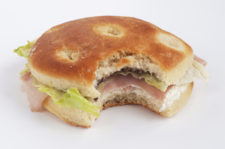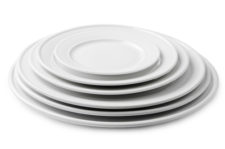 Bitten Sandwich via Shutterstock
Bitten Sandwich via Shutterstock
It seems that virtually every aspect of eating behavior is under scrutiny by some team of researchers in the hope that some overriding cue will be found that gets people to eat less. For example, we know that plate and portion size can significantly affect the amount of food consumed —
the bigger the plate, the more we eat — even a large portion looks small on a very large plate.
 Different Size Plates via Shutterstock
Different Size Plates via Shutterstock
Having the remains of food moved out of sight (e.g., the bones from chicken wings) can induce people to keep eating.
 Chicken Bones via Shutterstock
Chicken Bones via Shutterstock
Much of this research has been done in the lab of ACSH advisor Dr. Brian Wansink from Cornell University.
Now a group from Clemson University, led by Phillip W. Jasper, a Ph.D. student in the psychology department, has examined whether counting the number of bites a person takes can change the amount he or she consumes. In addition, the researchers asked whether the bite count could overcome the effect of the size of the plate on which the food was presented. Their work will be published in the Journal of the Academy of Nutrition and Dietetics.
The researchers recruited young adults for two studies; all had normal BMIs and were around 19-years old. In the first one, 62 women and 32 men were presented with a single course meal, using either a small or large plate. During this trial, the participants either did or did not wear a device that counted the number of bites they took.
Plate size had a significant effect on the amount of food the participants ate — the bigger the plate, the more bites they took, and the more food they ate (these results were for those not wearing a bite counter). Both of these effects were statistically significant. But those who got feedback from the bite-counting device they wore took fewer bites and ate less.
In the second study (56 women and 43 men), all the participants wore the bite counting device, and were given goals as to how many bites they should take — either 12 or 22 — during the course of the meal. The participants met their assigned bite goals. Again, the plate size had a significant effect on meal size — the larger the plate, the more food consumed, even if they were assigned only 12 bites. In such cases, the participants simply took larger bites.
Thus the study confirmed that providing feedback about one aspect of food consumption (bite number) can overcome the effect of another (plate size). However, since a person who wants to eat more can adhere to a bite number goal, and still consume more food. These studies enhance our understanding of factors that feed into food consumption amounts — but counting bites may not be the most effective way to lower the amount of food consumed.



